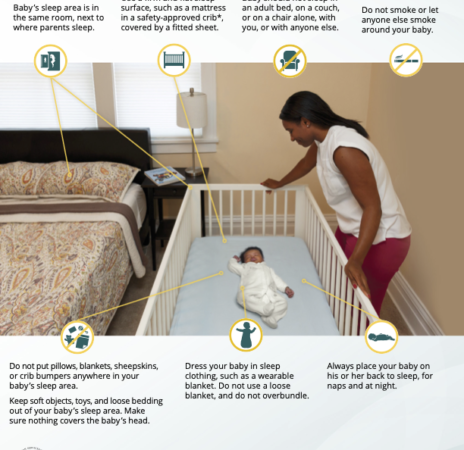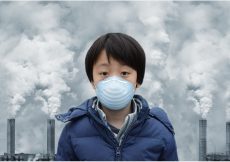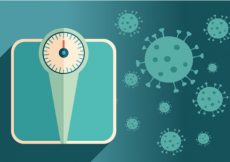April 7th, 2022
In 2016 The PediaBlog examined the key principles of creating a safe sleep environment for infants. We focused on the “ABCs of Safe Sleep”:
A — Alone (not with other people, pillows, blankets, stuffed animals or other soft toys)
B — on my Back (not on the stomach or side)
C — in a Crib (not on an adult bed, sofa, armchair, cushion, or other soft surface)
According to the American Academy of Pediatrics policy statement, “Recommendations for a Safe Infant Sleep Environment,” last updated in 2016, the safest place for an infant to sleep is “on a firm sleep surface (eg, mattress in a safety-approved crib) covered by a fitted sheet with no other bedding or soft objects to reduce the risk of SIDS and suffocation.”
A firm surface maintains its shape and will not indent or conform to the shape of the infant’s head when the infant is placed on the surface. Soft mattresses, including those made from memory foam, could create a pocket (or indentation) and increase the chance of rebreathing or suffocation if the infant is placed in or rolls over to the prone position.
Other than a sheet covering a firm mattress, nothing but the baby should go into the crib. Not even bumper pads:
Bumper pads or similar products that attach to crib slats or sides were originally intended to prevent injury or death attributable to head entrapment. Cribs manufactured to newer standards have a narrower distance between slats to prevent head entrapment. Because bumper pads have been implicated as a factor contributing to deaths from suffocation, entrapment, and strangulation and because they are not necessary to prevent head entrapment with new safety standards for crib slats, they are not recommended for infants.
Shortly after the policy statement was published, the AAP called on the Consumer Product Safety Commission to ban the sale of potentially dangerous (and completely useless) bumper pads. When the CPSC refused, pediatricians expressed their disappointment:
“Parents tell us that ‘if they sell them, they must be safe,’” Dr. Dreyer said. “Pediatricians and child health advocates will continue to call on the CPSC to protect infants by banning these dangerous products that serve no child health benefit.”
Others echoed his sentiments.
“Regulators are right to say that padded bumpers come with a clear risk of injury or death, and have no place in a baby’s crib,” said William Wallace, policy analyst for Consumers Union, the policy and mobilization arm of Consumer Reports. “But what kind of message does it send to consumers when these dangerous products are still on store shelves? It’s time for them to go.”
Five years later, the call to ban the sale of bumper pads has grown louder than ever, and for good reason:
According to data from the Consumer Product Safety Commission, 107 babies died in cribs with bumpers between 1990 and 2016, and 282 nonfatal incidents with bumpers were reported, including near-misses for strangulation and suffocation.
Despite this, bumpers are still widely sold by retailers.
A 2020 survey released by Johns Hopkins University found that many parents were unaware of the dangers posed by crib bumpers and assumed they would be removed from stores if found unsafe.
Finally last month, the United States Congress decided to take action:
The Senate on Mar. 23 approved a bill to ban the sale of padded crib bumpers, which have been deemed risky by public health experts.
The Safe Cribs Act, introduced by Sen. Rob Portman (R-Ohio) and Sen. Tammy Duckworth (D-Ill.), would prohibit making and distributing bumpers – soft pads made to protect babies from hard sides of cribs – which have been found to increase suffocation risk.
“The fact that these deadly products can still be found on shelves across the country is extremely confusing to new parents who don’t believe stores would be selling them if they were truly dangerous to babies,” Sen. Duckworth said in a statement.
The bipartisan bill awaits an almost certain affirmative vote in the House of Representatives before it is sent on to the president for his signature.
(Image: National Institutes of Health)




































